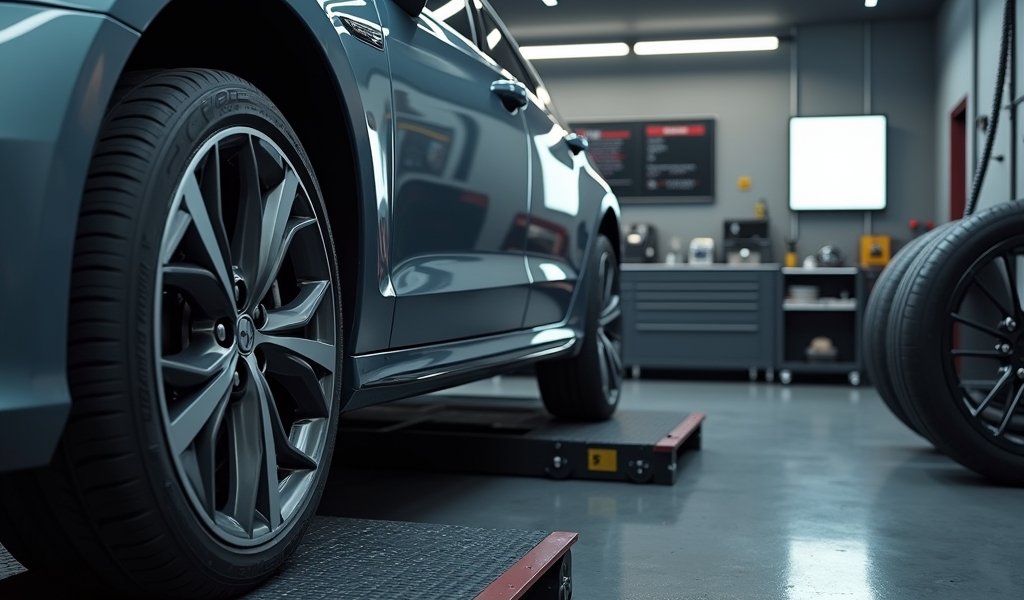Overview
This guide outlines five essential seasonal tire care practices: regular pressure checks, rotation, tread depth monitoring, proper seasonal tire selection, and professional inspections. Following these expert recommendations improves safety in all weather conditions while extending tire life and improving fuel economy.
Table of Contents
- Understanding Seasonal Tire Care
- Regular Tire Pressure Checks: Your First Line of Defense
- Seasonal Tire Rotation: Ensuring Even Wear
- Tread Depth Monitoring: Your Grip on Safety
- Seasonal Tire Selection: Right Rubber for Right Conditions
- Professional Seasonal Inspections: The Expert Touch
- Conclusion: Your Year-Round Tire Safety Plan
- Frequently Asked Questions
Understanding Seasonal Tire Care
Your tires are literally where the rubber meets the road. As a mechanic with over 15 years of experience, I can’t stress enough how critical proper seasonal tire care tips are for your safety and vehicle performance. Those four patches of rubber, each about the size of your palm, are all that connect your two-ton vehicle to the asphalt.
Weather changes throughout the year put different demands on your tires. The scorching summer pavements, rainy spring conditions, and icy winter roads each require different care approaches. I’ve seen too many preventable accidents caused by neglected tires that couldn’t handle seasonal transitions.
Let’s walk through five proven steps that’ll keep you rolling safely year-round. These aren’t just recommendations – they’re essential practices I’ve refined over thousands of tire services. Following these seasonal maintenance guidelines won’t just keep you safer – they’ll save you money by extending your tires’ life and improving your fuel economy.
Regular Tire Pressure Checks: Your First Line of Defense
If there’s one thing I wish every driver understood, it’s how dramatically temperature affects tire pressure. For every 10°F change in temperature, your tire pressure changes by roughly 1 PSI. That’s why your tire pressure warning light often comes on during the first cold snap of fall.
Here’s my seasonal pressure check schedule:
- Winter: Weekly (cold temperatures cause significant pressure drops)
- Spring/Fall: Every two weeks (fluctuating temperatures mean fluctuating pressure)
- Summer: Monthly (unless experiencing extreme heat waves, then bi-weekly)
Always check your pressure when tires are cold – before driving or at least three hours after parking. The recommended pressure isn’t the maximum PSI stamped on your tire’s sidewall! Look for the sticker on your driver’s door jamb or in your owner’s manual for the correct number.
I’ve seen underinflated tires reduce fuel economy by up to 3% while accelerating tread wear by 25%. Even worse, they compromise handling and braking – especially dangerous on wet or icy roads. Meanwhile, overinflation creates a rigid ride that’s more susceptible to impact damage and provides less traction when you need it most.
Properly checking your tire pressure is a simple five-minute task that pays enormous safety dividends. According to NHTSA research, maintaining proper tire pressure could prevent thousands of crashes annually.

Seasonal Tire Rotation: Ensuring Even Wear
I can spot a vehicle that needs rotation from across the shop. Front tires typically wear on outer edges from turning, while rear tires wear more evenly. Regular rotation redistributes wear patterns, extending your tires’ life significantly.
Different drivetrains need different rotation patterns:
- Front-wheel drive: Move front tires straight back; rear tires move to opposite sides at front
- Rear-wheel drive: Move rear tires straight forward; front tires move to opposite sides at rear
- All-wheel drive: Usually a cross pattern, but always check your manual
Align your rotation schedule with seasonal changes for maximum benefit:
- Early spring: After winter’s harsh conditions
- Early summer: Before extended hot-weather driving
- Early fall: Before rainy conditions intensify
- Early winter: Before snow and ice arrive
This quarterly approach keeps your tire rotation on schedule (roughly every 5,000-7,000 miles) while ensuring your tires are optimally positioned for each season’s challenges. I’ve seen proper rotation extend tire life by up to 20% – that’s real money back in your pocket.
During each rotation, I recommend having your tire balance checked. Seasonal temperature changes can affect how weight is distributed in your tires, and rebalancing prevents the annoying vibration that can develop at certain speeds.
Tread Depth Monitoring: Your Grip on Safety
Tread depth isn’t just about passing inspection – it’s about how effectively your tires channel water, snow, and slush away from the contact patch. As a mechanic, the most dramatic demonstration I show customers is the difference in stopping distance between new tires and worn ones on wet roads. The results are often shocking.
While the legal minimum tread depth in most states is 2/32″, that’s barely adequate for dry pavement. For real-world safety, follow these seasonal guidelines:
- Winter driving: 5/32″ or more for adequate snow traction
- Rainy seasons: 4/32″ minimum for effective water channeling
- Summer driving: 3/32″ minimum for adequate dry traction
The penny test works in a pinch – insert a penny with Lincoln’s head upside down in your tread groove. If you see the top of his head, you’re at or below 2/32″ and need new tires immediately. For more precise measurement, pick up an inexpensive tread depth gauge from any auto parts store.
Watch for these wear patterns that signal bigger problems:
- Center wear: You’re overinflating
- Edge wear on both sides: You’re underinflating
- One-sided edge wear: You need an alignment
- Scalloped patterns: Your suspension needs attention
Checking tread depth takes 30 seconds but could save your life. Consumer Reports testing shows that even 4/32″ of tread can increase wet braking distances by over 100 feet compared to new tires – that’s more than six car lengths!
Seasonal Tire Selection: Right Rubber for Right Conditions
All-season tires are like all-season jackets – adequate in mild conditions but not ideal in extremes. After years of seeing the real-world performance differences, I strongly recommend seasonal tire changes for anyone living where temperatures regularly drop below 45°F in winter.
Winter tires aren’t just about snow. Their special rubber compounds remain flexible in cold temperatures, while summer and all-season tires harden and lose grip. The tread patterns also feature additional siping (tiny slits) that create biting edges for snow and ice traction.
Switch to winter tires when overnight temperatures consistently fall below 45°F, and switch back when spring temperatures remain above that threshold. This temperature-based approach is more effective than calendar dates since climate patterns vary year to year.
When storing off-season tires:
- Clean them thoroughly with soap and water
- Store in a cool, dry place away from direct sunlight and ozone sources (like furnaces)
- Consider tire bags to prevent rubber oxidation
- Store flat or hanging – never stacked without support
While two sets of tires require more initial investment, the math works out. Each set lasts nearly twice as long since neither experiences year-round wear. More importantly, winter tires can reduce your stopping distance on snow and ice by up to 30-40%, according to tests from Tire Rack’s testing facilities.

Professional Seasonal Inspections: The Expert Touch
Even as a mechanic, I take my personal vehicle in for inspection twice yearly. There’s no substitute for a lift, proper lighting, and specialized equipment when it comes to comprehensive tire assessments. Professional inspections catch issues before they become dangerous – and expensive – problems.
A good seasonal inspection includes:
- Sidewall examination for damage, cracks, and bulges
- Valve stem integrity checks
- Wheel alignment verification
- Balance testing and correction
- Suspension component assessment
- Brake inspection (which affects tire wear)
Schedule these professional check-ups in early spring (to assess winter damage) and early fall (to prepare for winter conditions). When you visit your mechanic, come prepared with specific questions:
- “Do you see any impact damage to my wheels or tires?”
- “How even is the wear across all my tires?”
- “Are my tires showing age-related deterioration?”
- “Would you recommend an alignment with this rotation?”
Don’t just nod when your mechanic talks tire shop – ask for clarification on anything you don’t understand. A good mechanic (like myself) loves explaining the “why” behind recommendations. We want educated customers who understand the value of proper maintenance.
Professional inspections typically cost $20-50 but can save thousands in prevented damage and extended tire life. They’re especially important before long road trips when tire failure would be particularly inconvenient or dangerous.
Conclusion: Your Year-Round Tire Safety Plan
These five seasonal tire care steps – regular pressure checks, rotation, tread monitoring, appropriate tire selection, and professional inspections – form a comprehensive strategy that significantly improves your safety on the road. After working on thousands of vehicles over my career, I can confidently say that this approach prevents most tire-related issues before they happen.
Start implementing these practices today, beginning with a thorough inspection and pressure check. The peace of mind from knowing your vehicle can handle whatever season you’re driving in is invaluable. Plus, you’ll enjoy better fuel economy, longer tire life, and improved handling in all conditions.
Remember that tires are your vehicle’s only contact with the road. They might not be the most exciting auto component, but they’re certainly among the most critical for your safety. A few minutes of seasonal tire maintenance can prevent hours of roadside frustration – or worse.
Your tires literally carry the weight of your safety. Treat them with the care they deserve, and they’ll return the favor with years of reliable service through every season.
Frequently Asked Questions
How often should I check my tire pressure in winter?
Check tire pressure weekly during winter months. Cold temperatures cause significant pressure drops that can affect handling and fuel economy.
Can I rotate my own tires at home?
You can rotate tires at home if you have proper equipment including a jack, jack stands, and torque wrench. Safety is paramount, so ensure the vehicle is properly supported and lug nuts are torqued to manufacturer specifications.
What’s the minimum safe tread depth for driving in rain?
For safe driving in rainy conditions, maintain at least 4/32″ of tread depth. This depth ensures proper water evacuation to prevent hydroplaning.
Are all-season tires good enough for snowy conditions?
All-season tires are inadequate for significant snow or temperatures below 45°F. Winter tires provide up to 40% better traction in snow and ice conditions.
How can I tell if my tires are too old?
Check for dry rot (small cracks in sidewalls), manufacturing date (four digits on sidewall indicating week/year), and overall hardness. Most tires should be replaced after 6 years regardless of tread depth.

